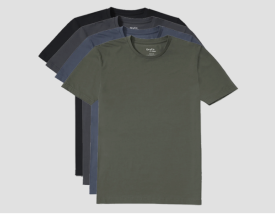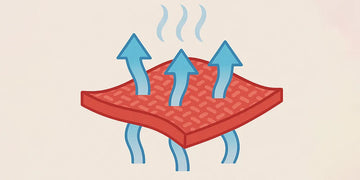All of us have felt that sudden stickiness under your arms, the rising heat trapped between the back and the shirt. And chances are, at some point, you’ve blamed polyester. But is polyester really the villain when temperatures spike or your heart rate jumps? The truth is more complicated than the label on your gym shirt would suggest.
Polyester gets a bad rap. It's in everything from bargain-bin polos to high-performance outdoor gear. But not all polyester is created equal, and breathability doesn’t live or die on fabric type alone. Sometimes it’s about how it’s made, not just what it’s made from.
Breathability Isn’t What You Think It Is
Let’s get one thing straight. Breathability has nothing to do with “skin breathing.” That’s not a thing. When we talk about breathable fabric, we’re really talking about how well a material lets moisture vapor (aka your sweat) escape. It’s all about how effectively the fabric helps your body cool itself through evaporation.
A breathable fabric pulls moisture off your skin and pushes it into the surrounding air. When it doesn’t, it traps that damp air against your body and you get that dreaded clammy, swampy feeling. And once that sets in, it's game over for comfort.
Polyester Demystified
Polyester didn’t stroll out of a cotton field. It’s synthetic, born in labs and spun from petroleum-based polymers. First developed in the 1940s, it exploded in popularity because it was cheap, tough, and didn’t care if you crumpled it in your gym bag.
It’s lightweight. It dries fast. It resists wrinkles like a champ. But pure polyester isn’t always your skin’s best friend, especially when it’s woven tight and unventilated.
What most people don’t realize is that polyester isn’t a monolith. There’s standard PET (polyethylene terephthalate), which dominates the market. But there’s also stretchier PCDT polyester, and even plant-based versions popping up in niche applications. And how these are constructed changes everything about how they behave when you start sweating.
Why Polyester Gets Blamed (And Sometimes Deserves It)
A lot of polyester garments, especially budget-friendly ones, aren’t designed with airflow in mind. The fibers are woven densely to keep costs down or maximize durability. That dense weave traps heat, and suddenly you’re stewing in your own sweat during your walk to the office.
That’s not the fault of polyester itself. It's the fault of how it's used. Even natural fibers like cotton or linen can feel suffocating if the weave is too thick. And a breathable synthetic can outperform a suffocating natural fiber on any given summer afternoon.
Breathability Is in the Build
You’ve probably worn a polyester T-shirt that felt like a plastic bag and another that felt light and airy. The difference? Construction.
Loose-knit polyester or mesh blends allow more airflow. Some poly fabrics are engineered with moisture-wicking technology that draws sweat away from your skin and spreads it across the surface, speeding up evaporation. That’s when polyester starts pulling its weight.
There are entire textile lines dedicated to this: think Polartec Power Dry, or those workout shirts that somehow stay dry even after a long run in July. These are crafted to move moisture like pros, not because polyester is magically breathable, but because it’s been manipulated to behave that way.
Polyester vs. Everything Else
Cotton breathes naturally. It’s soft, it’s familiar, and it feels great until you sweat. Cotton soaks it up, turns heavy, and takes forever to dry. Polyester, if it’s engineered well, might not be as cool to the touch, but it dries fast and doesn’t stick around feeling soggy.
Linen is breezy, no question. But it wrinkles if you even look at it the wrong way, and it’s not great with active sweat. Silk is soft and breathable, but fragile. Nylon? A cousin of polyester, but similar story: it breathes only if designed to.
Merino wool is surprisingly good in heat, but it’s pricier and more delicate. Bamboo sounds like the next eco-superhero, but again, performance depends on the weave. Same with modal, rayon, Tencel; fabric names alone won’t save you. It’s about how the final product is built.
Blends Are Where It Gets Interesting
This is where polyester gets sneaky good. When blended with natural fibers, you get some of the softness and breathability of cotton or linen, plus the strength, stretch, and shape retention of poly. Cotton-polyester blends, for example, offer better durability and less wrinkling than cotton alone—without completely sacrificing comfort.
Even adding spandex to the mix can change the game, giving polyester garments the flexibility you want in activewear while keeping things lightweight and smooth.
So What About Hot Days? Is Polyester a No-Go?
Not always. For sitting at your desk or grabbing lunch outdoors, moisture-wicking polyester can be totally fine. It’s light, it doesn’t wrinkle, and you can toss it in the wash without fuss. But if you’re biking uphill or chasing kids through a park in August, you’d better reach for the right version.
If it’s tight-knit and heavy, forget it. If it’s engineered for movement like moisture-wicking, mesh panels, UV coatings, it might surprise you. Some poly garments even offer decent sun protection, thanks to dense weaves and UV-blocking finishes.
On Warmth and Water Resistance
Polyester traps heat better than you’d expect, especially in layered or insulated garments. It’s not wool, but it holds warmth by resisting moisture and clinging close to the skin.
As for water? It won’t absorb it easily, but it’s not waterproof either—not without a little help. Add a durable water repellent (DWR) coating and you’ve got something close to rainproof. Without it, you’re water-resistant at best.
Making the Smart Pick for Summer
Choosing the right fabric isn’t about brand names or fiber labels. It’s about context. Will you be moving? Sitting? In the sun? Indoors with AC?
Here’s the unpolished truth: every fabric has trade-offs. Cotton’s comfy but gets swampy. Linen breathes but wrinkles. Polyester lasts forever and dries fast but needs engineering to stay cool.
The best gear for hot, active days? Look for synthetic fabrics specifically made for heat. Moisture-wicking polyester blends, mesh knits, ventilated panels—this is where performance meets comfort. Think Polartec Delta or Power Dry. Want sun protection too? Look for labels like Chitosante or Sun Lite Jersey.
Frequently Asked Questions
Is polyester always non-breathable?
No, not always. The basic form of polyester isn’t known for airflow, but once it’s engineered with moisture-wicking properties or loose weaves, it can be surprisingly breathable. It’s more about how the fabric is built than the material label.
Why does polyester feel hot sometimes?
Tightly woven polyester traps heat and moisture close to the skin, which creates that “greenhouse” effect people complain about. It’s worse in garments without ventilation panels or wicking tech. The feel isn’t just about the fabric—it’s about the way it’s constructed and the environment you’re in.
Is cotton better than polyester in hot weather?
Depends. Cotton feels great at first and is naturally breathable, but it absorbs sweat and dries slowly. That can make it clingy and heavy in the heat. Polyester, if designed right, can wick moisture and dry fast—so for activity, it might be the better choice.
Can polyester cause skin irritation?
For some people, yes. Especially when sweating. It’s not inherently harmful, but when polyester traps heat and moisture, it can aggravate sensitive skin. Breathable or blended poly fabrics are usually much more forgiving.
How do I know if a polyester shirt is breathable?
Check for clues: mesh panels, moisture-wicking labels, or technical fabric names like Polartec. Hold it up to the light—if it looks thick and tightly knit, it’s probably less breathable. Lightweight fabrics with a bit of stretch often perform better.
Will polyester make me smell worse when I sweat?
It can. Polyester tends to hang onto bacteria more than natural fibers, which is what causes lingering odors. Some high-end poly fabrics are treated with antimicrobial finishes that help prevent that. Washing with anti-odor detergent helps too.
Bottom Line
If someone asks you “Is polyester breathable?” you could say no and be technically correct or you could explain why the question itself is too narrow.
It’s not about polyester alone. It’s about what it’s blended with, how it’s constructed, and what you’re doing while wearing it. Fabric performance is a moving target that depends on design, activity, and environment.
So yeah, polyester can absolutely breathe if you know what to look for. And if you don’t, you’ll end up blaming your shirt when it’s really the stitch pattern and the marketing tag that let you down.
Don’t overthink it. Just don’t underthink it either.








